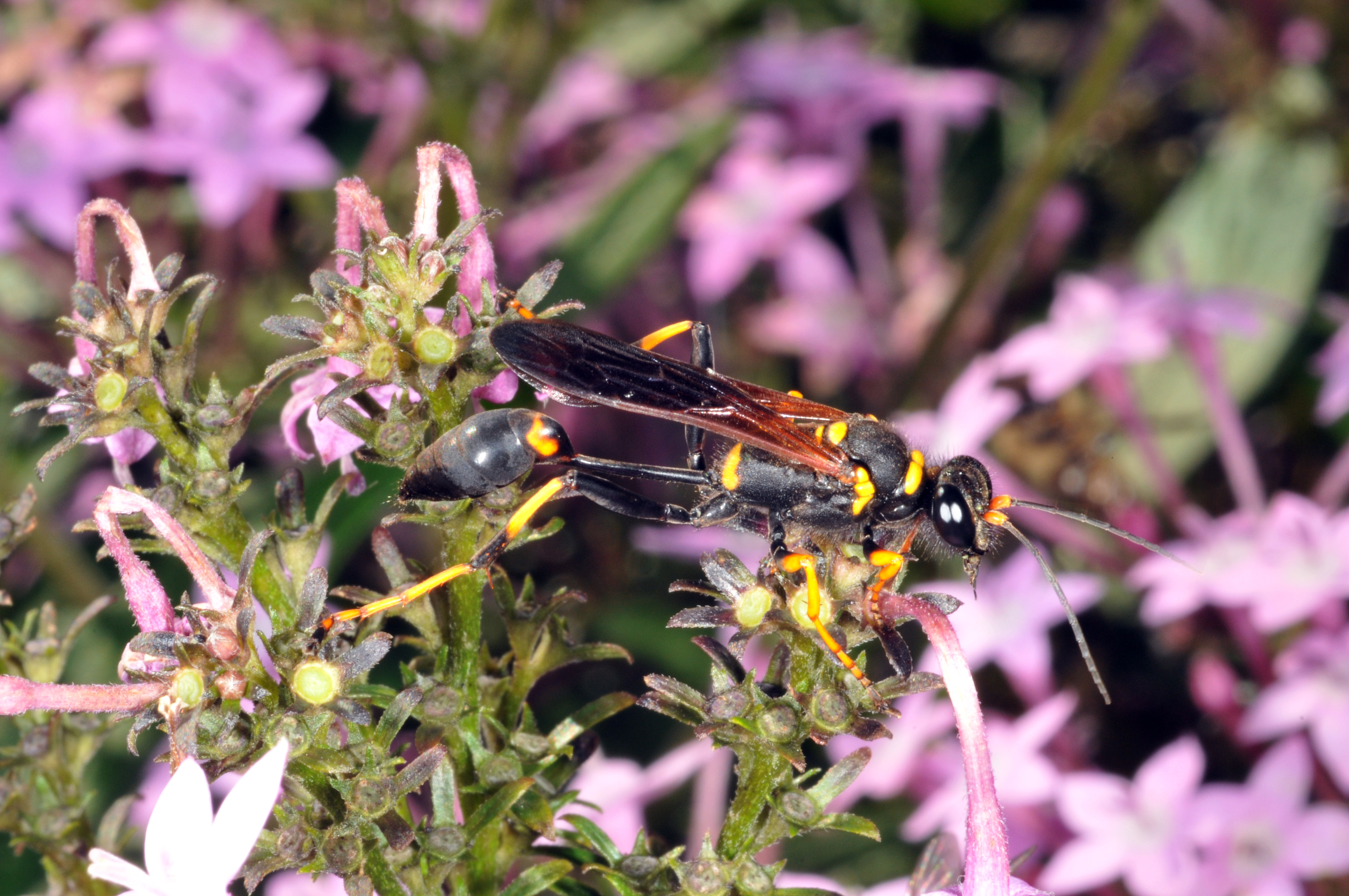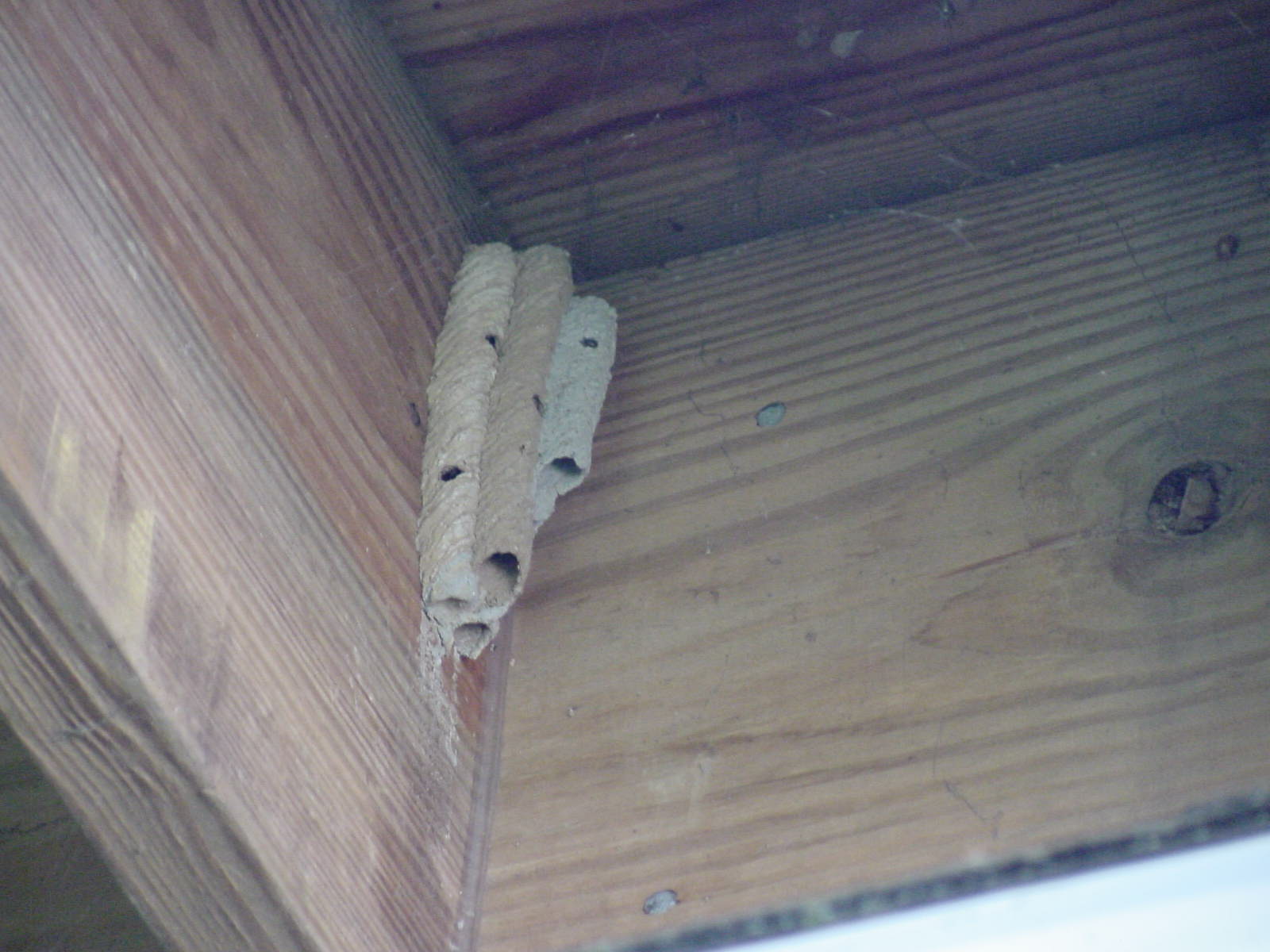household & structural
Mud Daubers
Timothy J. Gibb, Extension Entomologist
If you want to view as pdf, click here
A number of different solitary wasps reside in or around homes, yards, and gardens. Because of their frequent associations with humans, these insects often evoke a great deal of anxiety. However, solitary wasps very rarely sting, and then only if mishandled. Unlike their social relatives, paper wasps, hornets, and yellowjackets (see Purdue Extension Publication E-44-W, "Social Bees and Wasps"
Sometimes it is difficult to know if a wasp is social or solitary, because some solitary forms nest in aggregations. Generally, however, they can be distinguished by looking closely at the nest or burrow. Truly social wasps exist in large colonies associated with an elaborate nest, thus many individuals will be active at the nest entrance. In comparison, solitary wasps are not associated with a large nest. Typically there is only one individual in each nest or burrow.
Mud dauber. (Photo Credit: J. Obermeyer)
If the nest is constructed of mud, this is one of several species of mud dauber. Mud daubers are solitary wasps that construct small nests of mud on the sides of buildings, rafters of open structures, bridges and similar sites. These wasps are long and slender with a prominent thread-like waist.
There are three different wasps known as mud daubers in Indiana. The black and yellow species builds a series of cylindrical mud cells, which are eventually plastered over with mud to form a smooth mud nest about the size of a fist. The organ-pipe mud dauber is a more robust, black species that builds the characteristic pipe organ tubes on the sides of smooth surfaces, such as, walls and bridges. The third species is a beautiful metallic-blue to blackish wasp with blue wings. This one does not build its own mud nest but instead uses the abandoned nests of the black and yellow mud dauber.
The nest is often built on the flat surfaces of roof overhangs, eaves, and the undersides of wood and rocks. Each cell within a tube is filled with paralyzed spiders and a single wasp egg. When the egg hatches it feeds on the provisions (paralyzed spiders) already in the nest. Larvae complete feeding and spin a modified cocoon but do not pupae until the following spring.
These wasps do not aggressively defend their nests, as do yellow jackets and other more social wasps, however, they can sting if provoked. When they nest away from where humans live or work, they can actually be considered beneficial. In these cases, controls are not needed.
Should the wasps become a nuisance in areas where people live, they can be treated with a wasp and hornet aerosol spray, after which the nest can be scraped away with a putty knife and disposed of to prevent the emergence of mud daubers the following year.
For more information refer to E-63-W "Solitary Bees and Wasps: Carpenter Bee, Cicada Killer and Mud Daubers"
Mud tubes made by organ-pipe mud dauber wasps.
Species Information
Sceliphron caementarium (Drury) - a black and yellow mud dauber
Trypargilum politum (Say) - a black mud dauber that builds a pipe-organ structure
Chalybion zimmermani Dahlbom - a metallic-blue species that appropriates the nest of other mud daubers
READ AND FOLLOW ALL LABEL INSTRUCTIONS. THIS INCLUDES DIRECTIONS FOR USE, PRECAUTIONARY STATEMENTS (HAZARDS TO HUMANS, DOMESTIC ANIMALS, AND ENDANGERED SPECIES), ENVIRONMENTAL HAZARDS, RATES OF APPLICATION, NUMBER OF APPLICATIONS, REENTRY INTERVALS, HARVEST RESTRICTIONS, STORAGE AND DISPOSAL, AND ANY SPECIFIC WARNINGS AND/OR PRECAUTIONS FOR SAFE HANDLING OF THE PESTICIDE.
March 2018

It is the policy of the Purdue University Cooperative Extension Service that all persons have equal opportunity and access to its educational programs, services, activities, and facilities without regard to race, religion, color, sex, age, national origin or ancestry, marital status, parental status, sexual orientation, disability or status as a veteran. Purdue University is an Affirmative Action institution. This material may be available in alternative formats.
This work is supported in part by Extension Implementation Grant 2017-70006-27140/ IND011460G4-1013877 from the USDA National Institute of Food and Agriculture.
1-888-EXT-INFO
www.extension.purdue.edu
Order or download materials from www.the-education-store.com




